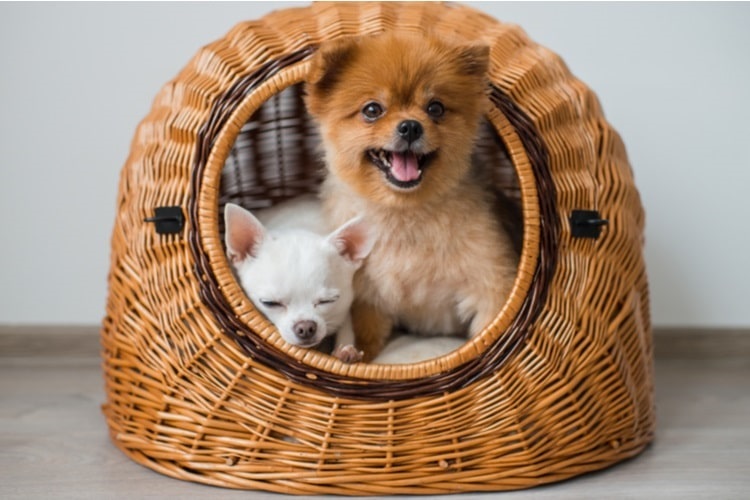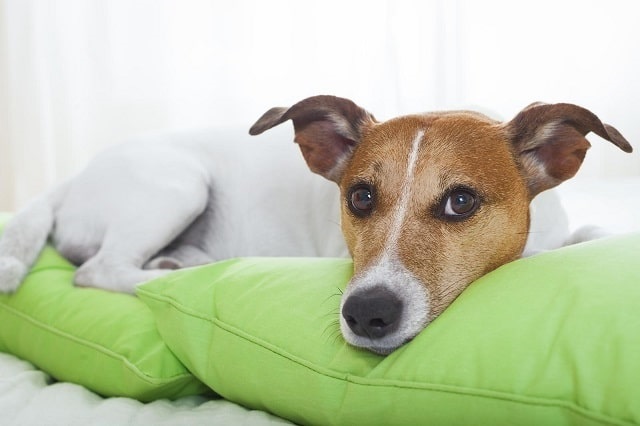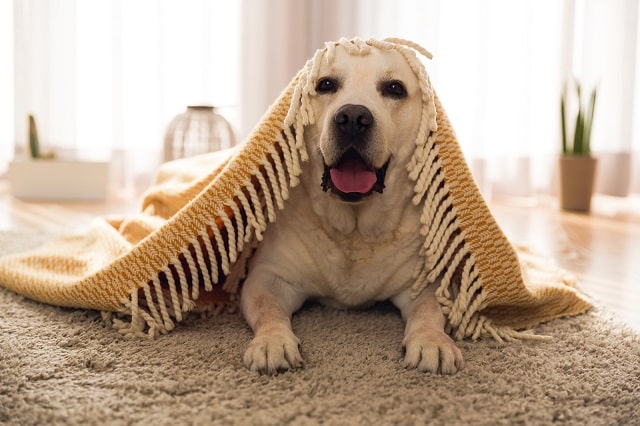You have just spent the time and effort to set up a nice house for your dog, and now you might be wondering what things to put in a dog house for bedding to keep your pup safe, comfortable, warm, and dry. In this article, I’ll explain the various types of dog house bedding to consider depending on the environment and your dog’s needs.
Before you select one of these things for your dog house, make sure to think about your particular dog house and its location. Is it an indoor dog house or an outdoor dog house? Think about the size of the dog house and the shape. Do you need a waterproof bed? Is the item you selected easy to wash, especially for outdoor dog houses, puppies, and senior dogs?
And, importantly, remember to think about the needs of your particular dog. See below for some added tips for puppies and senior dogs.
5 Types of Bedding for Your Dog’s House
1. Dog Bed
A great item to consider for dog house bedding is a dog bed. Dog beds come in all shapes and sizes, making it easy to select one that fits your space. A dog bed is also made for a dog to sleep on and will be durable for long-term use.
There are a variety of different materials that make up dog beds. For an indoor dog house, any bed you like may work well (some sofa dog beds may fit nicely). If this is for an outdoor dog house, you can consider different options like an elevated outdoor dog bed, a standard outdoor dog bed, or an outdoor dog bed that’s waterproof.
Most dog beds will come with a washable cover that helps to keep the bed clean.
While the perfect dog bed may be a bit of an investment, getting the one that suits your needs will be long-lasting and worth it.
2. Rug
A rug can work well for dog house bedding. A rug such as a bathroom rug or area rug works nicely. These rugs often have a rubber backing, making them non-slip. Rugs are easy to wash and come in many sizes and shapes. You can also choose the density and thickness of the carpeting to best suit your dog’s needs.
Rugs are also fairly inexpensive, which is nice for the budget. However, rugs are more likely to need replacement due to wear than some heavier-duty alternatives.
An indoor/outdoor rug can also be considered. While this will be less cozy, it will likely last a bit longer for outdoor use compared to an indoor rug.
3. Kennel Pad
A kennel pad (or dog crate pad or mat) is a good option for dog house bedding. There are many types of these pads that are fairly indestructible and durable.
Depending upon your needs, there are many thicknesses of kennel pads. It may be nice to have a pad that is not too thick, especially in hot environments. These pads also come in many sizes, though they do tend to be rectangular in shape.
Kennel pads will provide padding and some support. There are washable kennel pads, but depending upon the size, it may difficult to wash in a non-commercial washing machine.
4. Blankets
Blankets or linens also can work for dog house bedding. Blankets are easily bunched up into a cozy sleeping space for your pup. Blankets also offer soft support for your dog. Dogs tend to really like to get cozy into the blankets, so they usually feel very comfortable and safe in blankets.
Blankets are easy to wash and dry. Depending on your environment, blankets will likely need more washing and drying than other types of bedding.
A nice comforter can provide plenty of warmth and comfort for your dog.
5. Foam Pad Covered with Water Resistant Material
For those do-it-yourselfers out there, you can make your own dog house bedding. By using a foam pad and covering it with water-resistant material, you can create a bed that is like a combination of a dog bed and a kennel pad.
This works nicely as you can choose the type of padding your dog needs, something more comfortable and supportive for a senior dog, or maybe something thinner for a young dog and a smaller space. You can also customize the size and shape so it fits your dog’s house perfectly.
Depending upon the materials you choose, this will also be a more economical way to go.
How to Keep Your Dog House Bedding Safe
There are a few additional factors that you need to consider when deciding which of the above bedding makes sense for your dog.
First and foremost, is your dog a puppy or an adult chewer? If your dog chews and ingests items, then you don’t want a dog bed they will destroy. And, if they consume pieces of material, it can pose a health hazard, such as a gastrointestinal obstruction.1 For a destructive dog, consider kennel pads or maybe a dog bed that is intended for chewers. For a dog that is destructive, it is critical to monitor your dog and the bedding.
Also, really think about where your dog house is located. If it’s outdoors, then consider whether the bedding will attract insects. Does the bedding allow for good hiding spots for critters, especially snakes and rodents? Blankets and linens may be a hiding spot for these animals, so if you’re concerned about critters, you should choose an alternative.
For an indoor dog house, consider whether certain types of bedding might get too hot if the sun is shining on the house.2
Finally, for an outdoor dog house, consider cold temperatures and moisture.3 In some areas, you made need to change the bedding more frequently, and you may need waterproof material.
Special Considerations for Puppies
If you need dog house bedding for a puppy, there are a few special considerations.
Puppies commonly chew and eat items.4 Choose chew-proof material. There are kennel pads that are made of indestructible material, these are a good option for a strong chewer.
For puppies that are still potty training, consider bedding that can be easily washed. Again, most kennel pads and dog bed covers can be washed readily.
Special Considerations for Senior Dogs
Senior dogs need consideration too. As dogs age, their joints are more prone to the aches and pains of arthritis.5 To help their joints, make sure to choose dog house bedding that is supportive. I suggest orthopedic or memory foam dog beds that are moderately thick, but not so thick that it is hard for your dog to climb in.
Senior dogs may be more likely to have urinary incontinence issues also.6 Therefore, a washable and absorbent top layer for bedding is ideal.
If you keep all of these tips in mind, you will find bedding that will keep your dog safe and cozy in their house! Your pup is sure to enjoy their space for a long time to come.
Article Sources
Pet News Daily uses only high-quality sources, including peer-reviewed studies, to support the facts within our articles. Read our editorial process to learn more about how we fact-check and keep our content accurate, reliable, and trustworthy.
- Gibson TWG. Gastrointestinal Obstruction in Small Animals. Merckvetmanual.com. Updated June 2020. Accessed April 19, 2021.
- American Kennel Club Canine Health Foundation. Dehydration and Overheating in Dogs. Akcchf.org. Published December 6, 2011. Accessed April 19, 2021.
- Pedigree Foundation. How Cold is Too Cold for Your Dog? Pedigreefoundation.org. Published March 3, 2017. Accessed April 19, 2021.
- ASPCA. Destructive Chewing. Aspca.org. Accessed April 19, 2021.
- Anderson KL, O’Neill DG, Brodbelt DC, et al. Prevalence, duration and risk factors for appendicular osteoarthritis in a UK dog population under primary veterinary care. Sci Rep. 2018;8(1):5641. Published 2018 Apr 4. doi:10.1038/s41598-018-23940-z
- Washington State University. Urinary Incontinence. Vetmed.wsu.edu. Accessed April 19, 2021.



